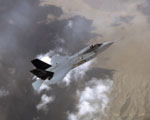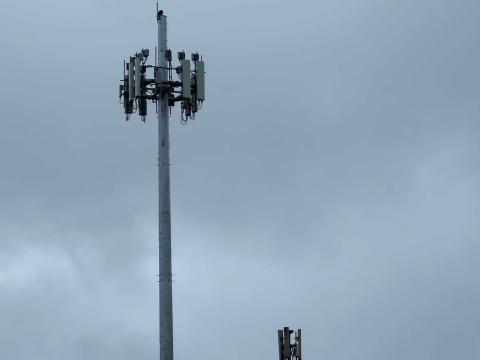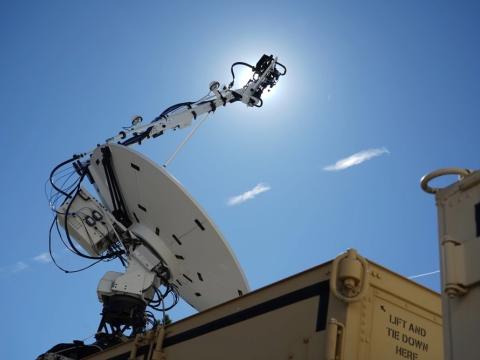Programmable System Guides Jet to New Heights
 |
| The F-35 Lighting II Joint Strike Fighter (JSF) will replace existing fleets of F-16s and F-18s in the United States and allied nations. The stealthy aircraft contains an advanced software-programmable avionics system that combines communications, navigation, identification and electronic warfare functions into a single unit. |
The
According to Colin Phan, director of business development at Northrop Grumman’s Software Defined Radio Products division in
Phan explains that the purpose behind the research was to combine multiple black box systems into a single software programmable unit with the goal of creating a system that could perform different capabilities at different times. For example, if an aircraft is taking off or landing, its integrated system may conduct different operations than in combat. “With software, you could change the functionality and mission of the box at a given point in time,” he says.
Intended to replace the current aging fleets of F-16s and F-18s in the United States and abroad, the F-35 (SIGNAL Magazine, October 2006) features many of the stealthy technologies used in the F-22 (SIGNAL Magazine, July 2006). The U.S. Air Force, Navy and Marine Corps will all fly their own JSF variants. The aircraft’s sophisticated electronics package allows it to interoperate with other platforms in a network-centric battlefield.
But building a complex avionics system with a variety of integrated functions presented many hurdles. Phan maintains that the real challenge for electronics is writing a specification. “When you write a specification for a transceiver module, for example, it [the module] has to do 30 different things. The communications are different from navigation and different from identification, but your RF [radio frequency] performance must support all of them because you’re making it all fit into a small area,” he says.
The F-35’s avionics system consists of a variety of software-programmable channels. Depending on the particular mission need, each channel can be programmed for a specific function. Phan notes that the JSF can perform more than 30 different system functions. Its identification friend or foe (IFF) system has five different modes to classify and identify friendly aircraft. Communications functions range from basic ultrahigh/very high frequency to single channel ground and airborne radio system (SINCGARS) and Have Quick. The aircraft also supports several datalinks for communications and situational awareness such as Link 16 and a specialized multi-array datalink (MADL) for stealthy communications between aircraft. He shares that MADL is scheduled to become the standard method for data transfer between the F-35 and F-22.
MADL was developed specifically to maintain JSF’s stealth capability. It is a K-band, narrow beam point-to-point datalink. Phan explains that when aircraft share data with each other via their datalinks, they can be tracked. He says that MADL is stealthy because it uses a narrow beam to communicate with other aircraft, making it very difficult to track an F-35 via its emissions.
The JSF’s software programmable communications system is written to the Joint Tactical Radio System (JTRS) software common architecture standard. However, Phan notes that while it is interoperable, the communications system is not part of the JTRS program. The F-35 uses two waveforms from the JTRS library, Link 16 and SINCGARS. This communications capability allows the aircraft to interoperate with JTRS radios in a variety of platforms. He adds that while the JTRS program will use four or five waveforms for its radios, the JSF will use many more because the aircraft must address navigation, identification or electronic warfare issues.
Although the JSF uses JTRS waveforms and software, it also includes software for a range of capabilities such as diagnostics, self-healing and reconfiguration. Phan notes that the system automatically reconfigures itself if there is a problem with a hardware channel. Another capability that distinguishes the F-35’s communications system from JTRS radios is the ability to schedule, transmit and receive signals that would normally interfere with each other in a time-ordered fashion that avoids co-site issues. “Because you’re integrated, you have the ability to schedule functions by microseconds so they don’t conflict with each other,” he offers.
Northrop Grumman already has delivered the JSF avionics package to JSF program prime contractor Lockheed Martin. Phan explains that the company will deliver the hardware in the first block followed by the software in the second block. The first block will provide both hardware and some operating software, followed by a full software load in the second block.
The JSF hardware also has been installed into a flying testbed and successfully demonstrated in airborne testing. The program is currently involved in integrating the hardware into the aircraft platform. Northrop Grumman’s final software and hardware delivery is scheduled for the 2009 to 2010 timeframe.
Phan adds that the communications, navigation and identification component of the JSF program is worth roughly $1 billion to Northrop Grumman. He estimates that it is the largest ongoing JTRS-related command, control, communications, and computer and intelligence program. Phan describes the F-35’s radio as perhaps the most sophisticated system of its kind in the world. “It’s an evolutionary step from what we did on the F-22,” he says.
The JSF’s communications system builds on lessons learned from the F-22 program. Phan explains that F-22’s radio system used a large amount of code. In the early stages of the Raptor program, the radio system encountered “stability events”—software-related systems crashes. As the work on the F-22 continued and the software became more robust, these lessons were incorporated into the F-35’s systems. “In the airplane [F-35], we quickly discovered that if the pilots lost their radar, EW [electronic warfare], or any function other than flight control, they would reset it. When they lost the ability to communicate, they got upset,” he says.
Beginning with the F-22, Northrop Grumman’s engineers learned many lessons about integration, compatibility between different functions and processing issues. The design and development of the JSF’s avionics benefited from this experience, Phan says. He notes that in the F-22 program, when a new function was added, multiple reduction tests had to be run to determine how the new component affected the system. In contrast, the JSF security architecture supports kernel separation to keep applications separate. This feature also allows new waveforms to be added without affecting the entire system. “On the F-22, every time we added a new wave form, something happened to the previous waveform,” he says.
High-bandwidth communications with other platforms are vital for networked operations. The F-22 program encountered difficulty when developers realized that the aircraft’s datalinks could not communicate with other types of aircraft. This need led to the development of the battlefield airborne communication node (BACN) that created a gateway between disparate datalinks. Instead of constantly transmitting data and consuming bandwidth, BACN stores information and only transmits it to users upon request. This system participated in the Joint Expeditionary Force Experiment 2007 (JEFX07) exercise. It also will be placed on an airborne testbed in the upcoming JEFX08 event to enable an F-22 to communicate with other types of aircraft, such as the F-35. The F-35 shares the F-22’s phased array radar and also uses phased array antennas for point-to-point communications between fighters.
Antennas also present an additional challenge. To maintain the F-35’s radar-evading silhouette, antennas must conform to the fighter’s shape. But building these systems into the skin of an aircraft can create issues such as co-site interference. Phan explains that one of the JSF program’s goals was to minimize the number of antennas on the aircraft. He adds that a ground vehicle can host a range of antennas for communications, jammers and other systems operating on the same band. The JSF does not have multiple antennas; its antennas operate on multiple frequencies and can perform different functions.
The Northrop Grumman avionics team is using the F-35’s electronics and software platform in other projects, but Phan admits that these are not mature enough to discuss. However, he adds that the company is exploring new applications for the system. With a planned production run of 25 years, the F-35’s business plan will cover the cost of obsolete parts by paying for old parts, technology insertion and waveforms. “If you look at that flywheel of production, sustainment and technology, that [the JSF avionics package] will be a good piece of hardware to put on another platform that doesn’t have a big program behind it,” he says.
Web Resources
Northrop Grumman Corporation: www.northropgrumman.com
F-35 Lightning II: www.jsf.mil




Comments